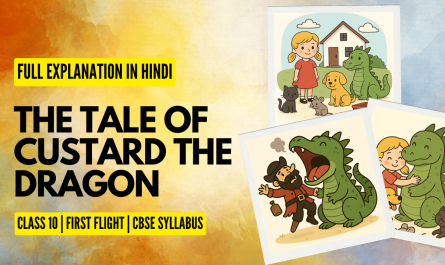Explanation | Summary | Poetic Devices | Main Themes | Class 10 CBSE Syllabus | First Flight
Short Summary of the Poem
In this poem, the poet presents two possible ways the world could come to an end — either by fire or by ice. Some people believe that fire will destroy the world, while others think it will be ice. The poet says he understands the “burning desires” within human emotions, so he agrees with those who say fire will bring about the end. However, he later reflects that if the world were to perish twice, ice would be just as capable of destroying it as fire.
The poet uses fire and ice as symbols of human emotions that can lead to self-destruction. Fire represents desire, greed, and lust — emotions that never seem to end. The more people try to satisfy them, the stronger and more consuming they become, just like fire. These feelings trap people in selfishness and cruelty. Ice, on the other hand, symbolizes coldness, hatred, and insensitivity. It reflects the harsh and uncaring side of human nature, where people stop valuing others’ feelings and become indifferent to their joys and sorrows.
Ultimately, the poet suggests that since both fire and ice are increasing rapidly in human nature, the world could end by either. The poem delivers a powerful message — human emotions control their actions, and if people fail to manage them, these emotions can destroy not only their lives but also the world around them.

Main Theme of the Poem
“Fire and Ice” is a short yet powerful poem written by the famous American poet Robert Frost. The poem explains human emotions in a very simple way. In just a few lines, Frost makes us think about how the world could end — either by burning in fire or freezing in ice. However, its true meaning goes beyond natural disasters. The poem symbolically shows that human feelings, such as uncontrolled desires and deep hatred, can be just as destructive as natural forces.
The poem highlights how strong human emotions can lead to destruction. The poet uses fire and ice as metaphors:
- Fire stands for desire, passion, and intense emotions. It represents human greed, longing, and wishes that can ultimately lead to destruction.
- Ice stands for hatred, coldness, and indifference. It represents hate, anger, and a lack of sympathy toward others, which can be equally harmful and destructive.
The message of the poem is clear — whether it is passion (fire) or hatred (ice), if these emotions are not controlled, they can destroy the world. In other words, unchecked emotions are always dangerous for both individuals and society.

Poetic Devices used in the Poem
- Metaphor: Fire and Ice are metaphors for human emotions — desire and hatred. They are used symbolically to represent intense feelings that can cause destruction.
2. Alliteration: The poetic device where similar sounds are closely placed. For example-
“Some say the world will end in fire,
Some say in ice.”
Here ‘s’ sound is repeated to give a musical effect.
3. Imagery: In this poem, the poet uses imagery, which helps the reader visualize the pictures of fire and ice and understand how destructive they can be. For example, fire creates an image of rage and uncontrolled anger, while ice brings to mind a sense of coldness and hard feelings toward others.
4. Personification: In this poem the emotions such as hatred and desire have been given human like qualities. For example, desire “can burn” and hatred “can freeze”- this tells us that these emotions can bring destruction.
5. Rhyme Scheme: The poem follows a simple rhyme scheme (ABA ABC BCB).

Poem
Poem
Some say the world will end in fire
Some say in ice.
From what I’ve tasted of desire
I hold with those who favour fire.
But if it had to perish twice,
I think I know enough of hate
To say that for destruction ice
Is also great
And would suffice.
Explanation
This poem expresses a deep idea — that the world can end in two ways. Some people believe it will end in fire, while others think it will end in ice. The poet himself understands the “burning desires” of human nature, so he agrees that if the world ends, it will be because of fire.
It’s like this — if you get one chocolate, you want another, then cake, then pastries! That’s exactly what “desire = fire” means — the more you get, the more you crave.
👉 Remember: Fire = desire, greed, lust. (One line, full marks!)
But then the poet thinks again — if the world were to end twice, ice would be just as powerful as fire. Ice stands for coldness, hatred, and rigidity — when people stop caring about others’ feelings and become stone-hearted.
Imagine this: your best friend in class suddenly starts ignoring you — no replies, no smile. Slowly, you start feeling like the friendship is over. That’s “ice = coldness.”
👉 Remember: Ice = hatred, coldness, insensitivity.
Fire is fast. Ice is slow. But both are destructive.
Robert Frost’s message is simple — if humans don’t control their emotions, those same emotions will destroy them. Both fire and ice represent self-destructive forces, and either one is enough to end the world.




